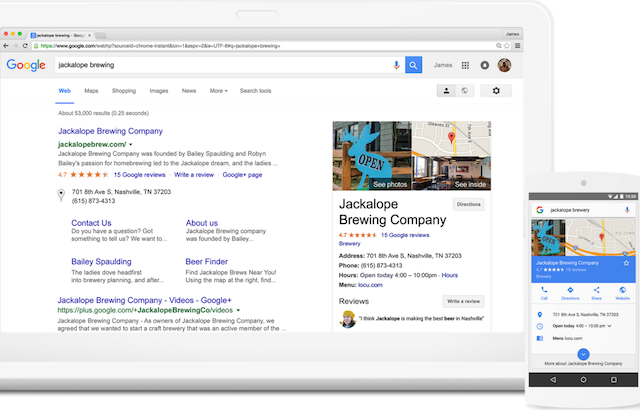Nowadays it’s hard to go anywhere without the internet at hand to tell you about the trendiest bars, the tastiest restaurants and the cheapest happy hours. With two-thirds of the population owning smartphones, and internet connectivity in just about every corner of every city, people on the go can easily search for the next great bottomless mimosa deal or dinner hot spot near them. This is where micro-local SEO comes into play.
Micro-local SEO is the ability for search engines to turn up results based on location.
After all, if you’re searching for the best tacos in town, you won’t be interested if the town is in another state. You want results based on where you’re standing at this particular moment.
In 2013, Fresh Egg reported that “four out of five people use smartphones to look up local information. Two in three people take direct action as a result and one in three people went on to make a purchase.” It’s safe to say that the numbers have just increased since then.
If you’re not taking advantage of local search on mobile, you’re missing out big time.
There are three things you can start doing now to help make sure the potential buyer on the street becomes your customer.
Get listed on Google My Business
Google My Business (formerly known as Google Places for Business) was specifically built to connect businesses with local customers; skipping it would be like skipping the flour when making a cake. When you register your business on Google My Business, you’re getting a leg up on the local competition with Google’s services. You get all the tools you need for locals to find you — a Google+ page, a flag on the map and better search returns.

Google My Business also makes it simple to ensure your information is always up to date, which is a must when it comes to micro-local. Providing information such as your address, hours of operation, category of business as well as more specific information such as whether you offer WiFi, accept credit cards or have outdoor seating, will make it that much easier for a potential customer to decide if your business is one they want to patronize.
Pro tip: To keep your various online business listings up to date from one convenient location, check out Winklix Get Found product.
Collect positive reviews
Potential customers are much more likely to take a tip from an unbiased opinion than from one with a subjective viewpoint (such as the business owner’s). In fact, many experts agree that good reviews have a big impact on search relevance.
Therefore, it’s of utmost importance to make sure you’re continually collecting positive reviews across the web. Having shining reviews on Yelp, Google+ and any number of social media platforms will make a world of difference in how often your business gets search returns — and the likelihood of potential customers becoming consumers.
Use Schema markup
Schema markup is a super-efficient tool that is very underutilized. It does a number of things, but essentially it makes it easier for users to find exactly what they’re looking for in specific searches, especially local ones. Here’s how Kissmetrics defines Schema markup:
“Schema markup is code (semantic vocabulary) that you put on your website to help the search engines return more informative results for users.”
This can work in your favor if you’re able to utilize Schema markup, and against you if you’re not. Because Schema is meant to be a user-oriented system, it works more in their favor than in yours unless you can master it. For example, simply producing solid content and providing basic location details is easier for you, but more frustrating for potential customers who may not know the nearest location for what they’re seeking. Hence, customers may find themselves taking an Uber across town instead of taking a short walk to the nearest destination because the results they found were not specific enough to their search.
However, with Schema on the rise, users can more easily discover exactly what they’re looking for and make a snap decision to buy.
Schema allows business owners to provide more specific information right on the search engine results page so potential customers can quickly browse, choose and purchase.
You can even use Schema to post a photo with the result, or offer a schedule of dates and times for upcoming events at your location without the user ever having to click on your site. This kind of rapid, easy-to-view information can make all the difference between purchase intent and purchasing.
Turn local searchers into buyers
There is a whole world of potential buyers out there, browsing their options on their mobile phones as we speak. The name of the game is to catch their attention as quickly and efficiently as possible, and turn their search into a step through your door and cash in your hand. When you take advantage of these three local SEO tools, you’ll have an edge when it comes to the micro-local competition.
Thanks,
No comments:
Post a Comment